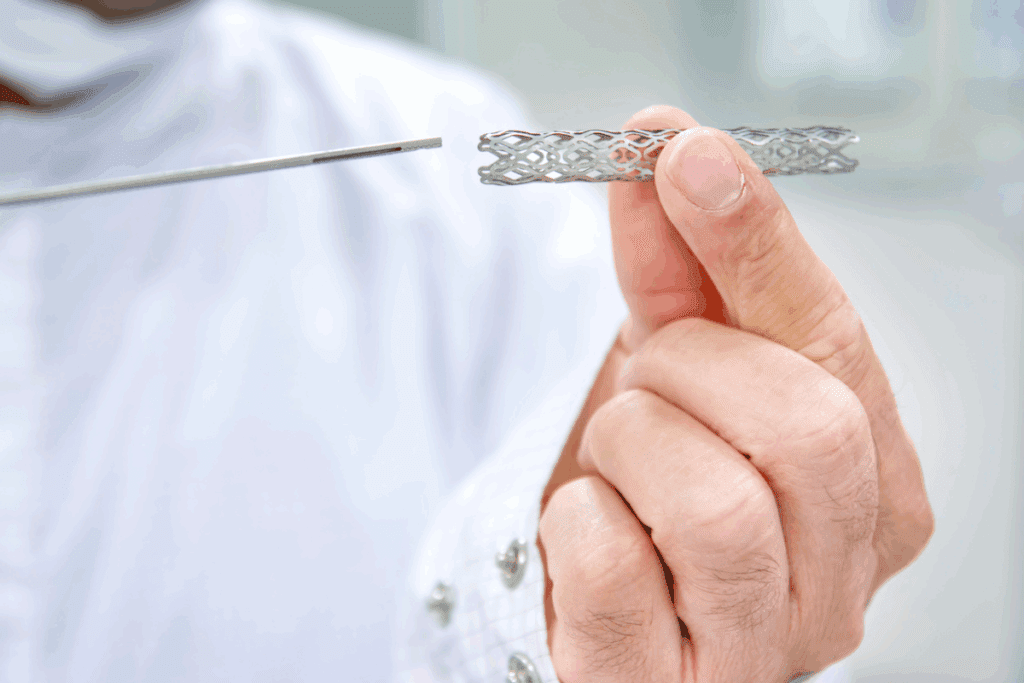Last Updated on November 26, 2025 by Bilal Hasdemir

Coronary stents have changed how we treat coronary artery disease. They have helped millions of people worldwide. At Liv Hospital, we know how important it is to talk about how long these devices last. Understand do heart stents need to be replaced and when replacement may be necessary.
Heart stents are made to last a long time. But, there’s always a chance of problems like restenosis. Our team uses the latest research and care to help patients. We explain how long their stents will last and if they might need more treatment.
It’s key for people with coronary artery disease to know about stent longevity. We’re here to give personalized advice and support.
Key Takeaways
- Coronary stents are a common treatment for coronary artery disease.
- The longevity of heart stents varies, and patients should be aware of possible risks.
- Restenosis is a possible complication that can occur over time.
- Our expert teams provide personalized care and guidance for patients with coronary artery disease.
- Understanding stent longevity is essential for making informed decisions about treatment.
Understanding Heart Stents: Purpose and Function

Heart stents are small, mesh-like devices. They keep coronary arteries open, improving blood flow to the heart. They are key in treating coronary artery disease, which can cause heart attacks.
What Are Heart Stents?
Heart stents are tiny, expandable tubes made of metal or a polymer. They are inserted into narrowed coronary arteries. This keeps the artery open, improving blood flow to the heart muscle.
This helps reduce the risk of heart attacks and eases symptoms like chest pain.
How Stents Treat Coronary Artery Disease
Coronary artery disease happens when plaque builds up in coronary arteries. This can lead to heart attacks. Stents treat this by keeping arteries open.
When a stent is placed, it ensures the artery stays open. This allows for enough blood flow to the heart. It’s vital for those with big blockages.
The Stent Placement Procedure
The stent placement procedure involves several steps. First, a catheter is inserted into the narrowed artery. A balloon on the catheter is then inflated to expand the artery.
Once expanded, a stent is placed to keep the artery open. The whole process is usually done under local anesthesia and takes about an hour. It can vary based on the case’s complexity.
Getting a stent placed can seem scary. But, thanks to medical tech advancements, it’s now safer and simpler. Patients often go home the same day or the next day, depending on their health.
Types of Heart Stents Available Today

There are many heart stents to treat coronary artery disease, each with its own benefits. The right stent depends on the patient’s health, disease severity, and artery characteristics.
Bare Metal Stents (BMS)
Bare metal stents are the first type made from metal. They keep the artery open after angioplasty. But, they have a higher chance of restenosis (re-narrowing) than newer stents.
A study in the Journal of the American College of Cardiology found a 20-30% restenosis rate for BMS in the first year. This led to the development of better stent technologies.
Drug-Eluting Stents (DES)
Drug-eluting stents are a popular choice for treating coronary artery disease. They release medication slowly, lowering restenosis risk. The drugs stop new tissue growth that can narrow the artery.
A study compared BMS and DES. DES lowered restenosis and repeat procedures. But, DES patients need dual antiplatelet therapy (DAPT) for longer to prevent stent thrombosis.
Bioresorbable Vascular Scaffolds (BVS)
Bioresorbable vascular scaffolds are a new stent type made from biodegradable materials. They support the artery during healing and then dissolve. This could reduce long-term stent complications.
The Absorb BVS, made from polylactide polymer, has shown good results in trials. But, the technology is evolving, and long-term data are needed to fully understand its benefits and risks.
| Stent Type | Key Features | Advantages | Disadvantages |
| Bare Metal Stents (BMS) | Made from bare metal | Simple design, less expensive | Higher risk of restenosis |
| Drug-Eluting Stents (DES) | Coated with medication | Reduces restenosis risk | Requires longer DAPT |
| Bioresorbable Vascular Scaffolds (BVS) | Made from biodegradable materials | Potentially reduces long-term complications | Stil an evolving technology |
As stent technology advances, choosing between BMS, DES, and BVS will depend on patient needs and clinical evidence. Knowing about these stents is key for informed coronary artery disease treatment decisions.
“The development of drug-eluting stents has been a significant advancement in the treatment of coronary artery disease, providing a more effective solution with reduced risk of restenosis.”
Medical Expert, Cardiologist
The Lifespan of Modern Heart Stents
Heart stents have changed how we treat coronary artery disease. But how long do they last? The life of a heart stent depends on its type, the patient’s health, and lifestyle.
Are Stents Permanent?
Most stents are meant to stay in the body forever. But “permanent” doesn’t mean they never need attention. Stents are durable but not completely trouble-free.
Stent longevity depends on the material and how well the patient follows care instructions.
“The introduction of drug-eluting stents has significantly reduced the incidence of restenosis, improving the long-term efficacy of stent placement procedures.”
— Medical Expert, Cardiologist
Durability of Different Stent Materials
The stent’s durability depends on its material. There are bare metal stents (BMS), drug-eluting stents (DES), and bioresorbable vascular scaffolds (BVS).
| Stent Type | Material | Durability |
| Bare Metal Stents (BMS) | Stainless Steel or Cobalt-Chromium | High |
| Drug-Eluting Stents (DES) | Metal with Drug Coating | Very High |
| Bioresorbable Vascular Scaffolds (BVS) | Biodegradable Polymers | Variable |
Factors Affecting Stent Longevity
Many things can affect how long a stent lasts. Patient health, lifestyle, and following medication are key. Lifestyle modifications like quitting smoking and eating well can help.
Understanding these factors and making smart choices can help patients get the most from their stents. This keeps their heart healthy for longer.
Do Heart Stents Need to Be Replaced?
Many patients wonder if heart stents need to be replaced. Most modern stents are meant to be permanent for treating coronary artery disease. But, there are times when more stenting is needed.
The Permanent Nature of Most Stents
Today’s heart stents are made to stay in the arteries forever. They help keep the arteries open, improving blood flow to the heart. Drug-eluting stents release medicine to stop the artery from getting narrow again. Thanks to new technology, these stents are a trusted way to fight coronary artery disease.
When Additional Stenting May Be Required
Even though stents are meant to be permanent, sometimes more stenting is needed. Problems like restenosis (when the artery narrows again) or blood clots might require more treatment. In these cases, patients might need more stenting or other treatments to fix the issue. For more details, check out Medical News Today.
Misconceptions About Stent Replacement
There are many wrong ideas about replacing heart stents. Some think stents must be replaced after a set time, but that’s not always true. How long a stent lasts depends on the stent type, the patient’s health, and following doctor’s advice. It’s key for patients to listen to their doctors to keep their stents working well.
Common Complications That May Affect Stent Performance
Heart stents can have complications that worry both patients and doctors. Stents are usually safe and work well. But, knowing about possible problems helps in taking care of patients better.
Restenosis: Re-narrowing of the Artery
Restenosis is a big risk with heart stents. It happens when the body forms scar tissue around the stent, making the artery narrow again. Restenosis rates differ based on the stent type; drug-eluting stents have lower rates than bare-metal stents.
Things that can lead to restenosis include:
- Stent material and design
- Patient’s overall health and medical history
- Following medication after the stent is placed
Stent Thrombosis: Blood Clot Formation
Stent thrombosis is another serious issue. It’s when blood clots form on the stent, which can cause a heart attack. The risk of stent thrombosis is higher in the first few months after stent placement. This is why taking two medicines to prevent blood clots is key during this time.
To lower this risk, doctors usually prescribe:
- Aspirin
- A P2Y12 inhibitor (like clopidogrel)
Other Possible Complications
Other issues can also happen, like:
- Infection at the stent site
- Bleeding because of blood-thinning medicines
- Allergic reactions to the stent material
Even though these problems can occur, new stent technologies and better care have made them less common. It’s important to see a doctor regularly to check on the stent and talk about any worries.
Medical Procedures for Stent-Related Issues
Heart stents can sometimes cause problems. When this happens, doctors have several ways to fix the issue. We’ll look at the medical steps taken to handle these problems.
Can Stents Be Removed?
Removing a stent is not common and is hard to do. Stents are meant to stay in the arteries forever. But, if there’s a big problem like a blockage, doctors might need to take it out.
Here are some reasons a stent might be removed:
- Infection or a bad reaction to the stent
- The stent isn’t working right or has blocked
- There’s a big problem with the stent that can’t be fixed another way
Removing a stent is a tricky procedure. It’s done with special tools through a catheter. It’s risky, so doctors are careful.
Secondary Stent Placement Procedures
If a stent fails, doctors might put in a new one. This new stent goes inside or next to the old one. It helps keep blood flowing.
Secondary stenting is used for:
- When the old stent gets clogged again
- When the stent gets blocked
- For new blockages near the old stent
Stent technology has improved. Now, drug-eluting stents work better than old stents. They help prevent clogs.
Alternative Interventions When Stents Fail
When stents don’t work, doctors have other options. These include:
- Balloon angioplasty to open the artery
- Atherectomy to clean out plaque
- Coronary artery bypass grafting (CABG) for serious cases
Choosing the right treatment depends on the problem, the patient’s health, and the stent and artery details.
New treatments and procedures are being developed. They offer more ways to deal with stent problems and help patients get better.
Long-Term Monitoring After Stent Placement
Monitoring heart stents long-term is key. It helps catch problems early and keeps the heart working well. We help our patients set up a schedule for check-ups and tests to check the stent’s status.
How Often Should a Heart Stent Be Checked?
The check-up schedule for heart stent patients varies. It depends on their health and the stent type. We suggest a first visit with the cardiologist soon after the stent is placed. Then, regular visits every 6 to 12 months are recommended. Sticking to this schedule is important for checking the stent’s work and fixing any problems fast.
Diagnostic Tests for Stent Evaluation
There are several tests to check how well heart stents are working. These include:
- Stress Tests: To see how the heart works under stress and find any ischemia signs.
- Coronary Angiography: Uses X-rays to see the coronary arteries and the stent.
- Cardiac CT Scans: Gives detailed images of the heart and blood vessels.
These tests help us keep an eye on the stent and the heart’s health. They let us act quickly if there’s a problem.
Warning Signs That Require Medical Attention
It’s important for patients to know the signs of stent trouble. These include:
- Chest pain or discomfort
- Shortness of breath
- Fatigue or weakness
- Dizziness or fainting
If you notice any of these symptoms, get medical help right away. Catching and treating problems early can greatly improve outcomes.
Lifestyle Factors That Impact Stent Longevity
Many lifestyle choices can affect how long a heart stent lasts. After getting a stent, it’s key to keep your heart healthy. This helps the stent work well.
Medication Adherence
Medication adherence is very important. People with heart stents need to take antiplatelet therapy to stop clots. Taking your meds as told is key to avoid problems like stent thrombosis. Always follow your doctor’s advice to keep the stent working right.
Diet and Exercise Recommendations
Eating well is a big help. A heart-healthy diet should include lots of fruits, veggies, whole grains, and lean meats. Try to eat less saturated fats, cholesterol, and salt. Also, regular physical activity like walking or swimming is good for your heart. Talk to your doctor to make a plan that’s right for you.
Risk Factor Management
Managing risks is key for heart stent patients. This means keeping blood pressure, diabetes, and cholesterol in check. Quitting smoking is also a must, as it raises the risk of stent failure and heart problems. We help patients manage these risks to boost their heart health.
By paying attention to these lifestyle choices, patients can make their heart stents last longer. This improves their life quality and lowers the chance of future heart issues.
Conclusion
Knowing how long heart stents last is key for those with coronary artery disease. We’ve looked at the different types of stents. These include bare metal stents, drug-eluting stents, and bioresorbable vascular scaffolds. Each has its own benefits and features.
The life of a heart stent varies based on several factors. These include the stent type, the patient’s health, and lifestyle. While most stents are meant to stay in place forever, some might need more procedures. This could be due to issues like restenosis or stent thrombosis.
Following medication, eating well, and exercising can help a stent last longer. It’s also important to manage risk factors. Regular check-ups with healthcare providers are key for the best results.
As medical technology improves, so will how we manage coronary artery disease and heart stent care. This will lead to better outcomes and a better quality of life for patients. We aim to offer full support and guidance to those facing heart health challenges.
FAQ
How long do heart stents last?
Heart stents’ lifespan changes based on several things. These include the stent type, health, and lifestyle. Most stents are meant to stay in place forever. But, the material used can affect how long they last.
Do heart stents need to be replaced?
Most heart stents are meant to stay in forever. But, sometimes more stents are needed. This can happen if the artery narrows again or if blood clots form.
Can stents be removed?
Removing stents is possible, but it’s not common. The approach depends on the problem with the stent.
How often should a heart stent be checked?
It’s important for patients to keep up with check-ups and tests. This helps doctors see how the stent is doing.
What are the common complications that may affect stent performance?
Two big risks are restenosis and stent thrombosis. Restenosis is when the artery narrows again. Stent thrombosis is when blood clots form on the stent.
Can lifestyle factors impact stent longevity?
Yes, lifestyle choices can help the stent last longer. Taking medicine as directed, eating well, and exercising regularly are key.
Are stents permanent?
Most heart stents are made to stay in forever. But, the material they’re made of can affect how long they last.
What is the lifespan of a stent?
A stent’s lifespan depends on several things. These include the stent type and the patient’s health.
Can cardiac stents be removed and replaced?
Removing stents is possible, but it’s rare. Sometimes, more stents are needed to fix problems.
How long do stents last in arteries?
How long a stent stays in an artery varies. It depends on the stent type and the patient’s health.
References
- Kastrati, A., Hall, D., Schömig, A. (2000). Long-term outcome after coronary stenting. The European Heart Journal, 21(12), 946-951. https://pmc.ncbi.nlm.nih.gov/articles/PMC59599/






